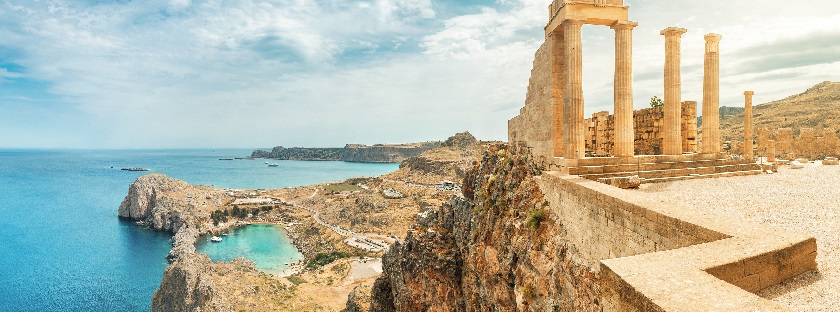
Once a center for ancient Greek religious life, the Sacred Rock of the Acropolis is now one of Athens’ most famous historical sites. From celebrating festivals of the gods of old to housing royalty throughout the ages, the Acropolis has remained standing proudly above the city.
Even more exciting, you can see it in person. What makes this trip truly special is the ability to peek into the world of the ancient Greeks — and even further back to the civilizations that came before them.
Let’s step back in time to visit the Acropolis of old and learn about how it’s evolved.
In This Article
- What Is the Acropolis?
- Who Built the Acropolis?
- The Acropolis Through the Ages
- Who Destroyed the Acropolis?
- Tips for Visiting the Acropolis
- Explore Ancient Greece on a Windstar Cruise
What Is the Acropolis?
The Athenian Acropolis has served many purposes throughout the centuries, but it’s most well-known as an ancient religious site. Today, the Acropolis is a UNESCO World Heritage site and a popular tourist attraction.
The word “acropolis” literally translates to “high city.” While the term can technically refer to any elevated stronghold in the country, the Acropolis of Athens is the most famous.
Resting on top of the Attica plateau in Athens, the Acropolis consists of four hills:
- The Hill of the Nymphs
- Likavitos Hill
- Philopappos Hill
- The Pnyx Hill
Atop these hills are some of antiquity’s most magnificent structures, which have survived mostly intact. These buildings have left an outsize impact on Western architecture, inspiring many neoclassical designs such as those that were popular during the Renaissance.
Who Built the Acropolis?
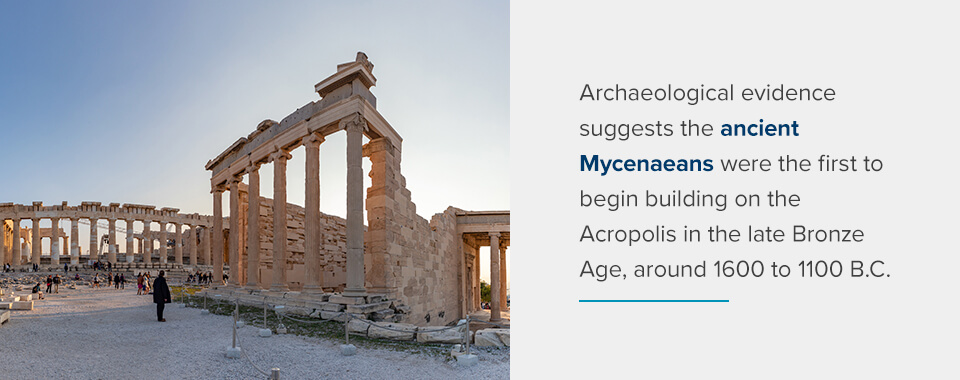
Archaeological evidence suggests the ancient Mycenaeans were the first to begin building on the Acropolis in the late Bronze Age, around 1600 to 1100 B.C. While none of their original structures remain, historians believe they built a fortified stronghold for the local ruler and his family.
The Acropolis as we know it today was the result of an ambitious building plan by legendary statesman Pericles in the fifth century B.C. While the project initially faced criticism from other prominent Greek politicians who believed it was too extravagant, Pericles ended up going through with his project.
Pericles commissioned three renowned artisans — architects Ictinus and Callicrates and sculptor Phidias — to help design and build the new Acropolis. These individuals built the four structures that you can visit today.
Although the Acropolis faced many changes throughout the ages, much of its original glory has remained.
The Acropolis Through the Ages
The UNESCO World Heritage Convention calls the Acropolis an “outstanding example” of a site that has been present through significant periods of change. As a central hub for one of the oldest civilizations on earth, it’s an amazing monument to human history.
Here’s a brief overview of important moments in Acropolis history.
The Mycenaean Acropolis
Mycenae was a Bronze Age civilization that lived in Athens from around 1600 B.C. to 1100 B.C. According to myth, the legendary hero Perseus founded the city-state, enlisting cyclopes to build the fortifying wall around it.
Archaeological evidence suggests that the civilization’s elites occupied the Acropolis starting around 1600 B.C. At the center of their fortified city was the megaron, a central hall characteristic of Mycenaean palaces.
Little is left of the original palace, which was located where the Erechtheion is now. However, historians believe this structure housed the local king and his household.
Although historians are unsure why, the Mycenaean civilization began declining around 1200 B.C. The ancient Greeks replaced them sometime around the eighth century B.C.
Archaic Greece: The Hekatompedon Temple
The archaic Greek civilization thrived from 800 to 499 B.C., constructing new buildings on the Acropolis and developing a strong tradition of art and culture.
At that time, the largest structure on the site was the Hekatompedon, or the Pre-Parthenon. This structure was a large limestone temple dedicated to Athena, the Greek goddess of wisdom and war.
One of the most prominent sculptures on the temple was a three-headed man-serpent. All three of the heads had brightly painted blue beards, which earned the building the nickname of “Bluebeard Temple.” This temple originally occupied the same space where the Parthenon stands today.
Other archaic structures that existed on the Acropolis include:
- Brauroneion: The Sanctuary of Artemis Brauronia, the protector goddess of women during pregnancy and childbirth, sat on the southwest corner of the Acropolis between the now-demolished Chalkotheke and the Propylaea.
- Chalkotheke: The Chalkotheke, Greek for “Bronze Store,” was an ancient building that served as a storehouse for the treasury’s metal. Only a portion of its limestone foundation remains today.
After the collapse of the Hekatompedon, the Athenians began building a new marble temple known only as the Old Parthenon. This structure — as well as everything else on the hill — was destroyed in the second Persian invasion.
The Athenian Golden Age
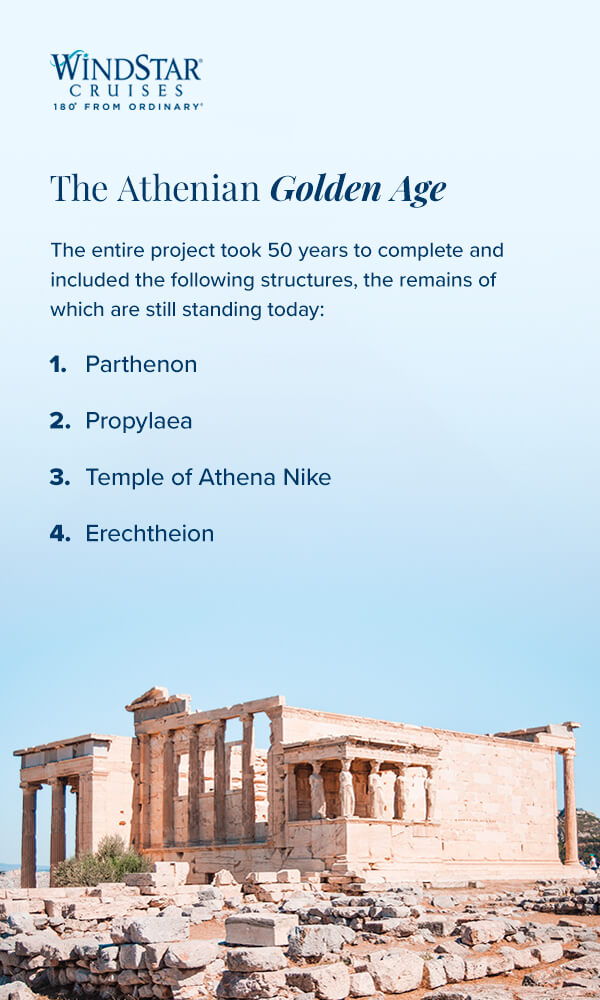
Athens reached its cultural peak between 480-404 B.C. Under the rule of the Athenian statesman Pericles, the city-state transformed into the artistic and intellectual hotbed that would raise some of the most influential Western thinkers, including Socrates, Plato, Herodotus and Hippocrates.
The entire project took 50 years to complete and included the following structures, the remains of which are still standing today:
- Parthenon: Constructed between 447 and 432 B.C., this colossal Doric-style temple honored the Greek goddess Athena Parthenos (“Athena the Virgin”). Inside the Parthenon was an enormous statue of Athena, which is no longer there.
- Propylaea: The Propylaea is the enormous set of gates that serves as the entry to the Acropolis. It consists of two wings flanking one central building that some scholars believe to have been a place for visitors to rest.
- Temple of Athena Nike: This small Ionic Temple was once a shrine to Athena Nike (Athena as the goddess of victory). It sits next to the Propylaea and replaced an earlier temple that had been destroyed in the Persian Wars.
- Erechtheion: Constructed between 421 and 406 B.C., this marble temple features an iconic porch supported by six Caryatids — statues of women that serve as support columns. Its original purpose was to house an ancient wooden statue of Athena, but it has been repurposed several times since its initial construction.
The ancient fortification wall, left by the Mycenaeans, still encircled the Acropolis at this time. It is still standing, though it has been restored multiple times throughout the ages.
Hellenistic and Roman Period
While little changed on the Acropolis after the Romans conquered Greece in 146 B.C., they did build a new minor temple dedicated to Rome and Caesar Augustus. This marble temple, constructed in 27 B.C., was a circular Ionic structure located next to the Parthenon. Only the foundations of the temple’s pillars remain.
After the Roman Empire had converted to Christianity in the fourth century A.D., many of Greece’s ancient temples were repurposed as Christian churches. That included the Parthenon, which was rededicated to the Virgin Mary in the sixth century A.D. Similarly, the Erechtheion served as a Christian chapel for much of the medieval period.
The Acropolis Today
Centuries later, people still flock to the Acropolis in droves — but not for the same reasons they once did. UNESCO designated the Acropolis as a World Heritage site in 1987, and it’s been a popular tourist site ever since.
That said, today’s Acropolis looks much different from Pericles’ original construction project. Throughout the generations, construction on the Acropolis never stopped. Each new occupying force remodeled or added to the ancient structures that were already there, repurposing the site for the world’s changing needs.
Here are some examples of those post-Classical changes:
- Franks: Historians believe the medieval Franks constructed the Frankish Tower, a large watchtower, near the Propylaea, sometime in the 14th century. However, because the Greek government demolished the Tower in 1874, its history is impossible to determine with certainty.
- Ottoman Empire: While the Ottoman Empire controlled Greece, the Parthenon was converted from a church to a mosque and later into a gunpowder magazine. This final repurposing led to the temple’s destruction in the late 17th century.
- Greek independence: After the 19th-century Greek War of Independence, the new Greek government embarked on a large-scale project to restore the Acropolis to its original, pre-Roman appearance. This project demolished anything built after the Classical period.
While these evolutions mean today’s Acropolis is quite different from its original appearance, its ancient roots are still unmistakable.
Who Destroyed the Acropolis?
It’s tough to point to any specific group as the one that destroyed the Acropolis since the site experienced heavy damage from many attackers throughout its long history. Here are a few of the most notable incidents.
The Persian Wars: 499 to 449 B.C.
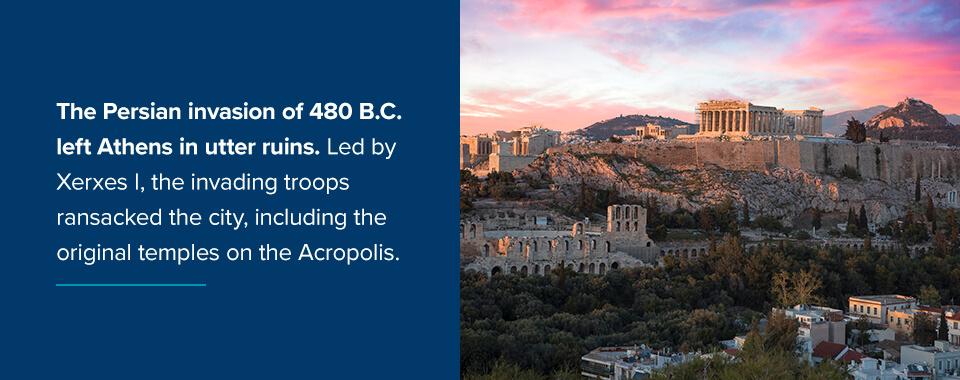
The Persian invasion of 480 B.C. left Athens in utter ruins. Led by Xerxes I, the invading troops ransacked the city, including the original temples on the Acropolis.
After the attack, surviving Athenians conducted a religious ceremony where they buried the desecrated temple remains on the mountain. Interestingly, it was this ceremony that allowed future archaeologists to uncover these pieces centuries later.
The 1687 Siege of the Acropolis
The Ottoman Empire — based in what is now modern-day Turkey — occupied Greece from the mid-15th century to 1832. In the late 17th century, the Ottoman Empire was involved in a territorial war with the Republic of Venice. The Venetians first attacked the Propylaea, laying siege to the Acropolis.
Hoping the Venetians would not attack another historical monument, the Turks turned the Parthenon into a gunpowder arsenal. But they misunderstood their enemy. On September 26 of 1687, the Venetian army opened fire on the Parthenon, detonating the gunpowder at its center and reducing the cella’s walls to rubble. The blast also knocked out several of the Parthenon’s columns, utterly destroying a significant portion of the structure.
The Removal of the Elgin Marbles
One of the most controversial incidents to happen to the Acropolis happened in 1801, when Thomas Bruce, the seventh Earl of Elgin, decided he was going to reproduce parts of the Parthenon for preservation purposes.
Elgin, then the British ambassador to the Ottoman Empire, claimed to have received permission from the occupying Turkish government to do more than simply copy the monument — he could remove whatever pieces he wanted. Some modern historians believe this claim to be a misinterpretation.
Elgin ended up removing a significant amount of pieces from the temple and brought them back to England with him. The collection, nicknamed the Elgin Marbles, includes:
- Fifteen metopes (decorative stone slabs) from the Parthenon
- About half of the Parthenon’s surviving frieze
- One caryatid and one column from the Erechtheion
- Four slabs from the Temple of Athena Nike
- Several other pieces from other sites in Athens
He then sold this collection to the British Museum in 1832, where it remains to this day. To this day, the Greek government is negotiating with the British government to return the Marbles to their original homes.
Tips for Visiting the Acropolis
If learning the history of this amazing monument got you excited to see it in person, we’re here to help! Here are some of our top tips for making the most out of your trip to the Acropolis:
- When to go: Beat the crowds — and the hot Greek sun — by getting there as early as possible. Summer evenings are also good times to visit, as the Acropolis closes at sundown.
- What to bring: Pack lightly since you’ll be doing a lot of walking. Make sure to bring comfortable shoes and plenty of water. You may also want to bring some sunscreen and light snacks for later in the day.
- How to get there: Taking a taxi from Athens will be the easiest way to get to the base of the Acropolis, but you can also take the metro. You’ll get off at either the Acropolis station or the Monastiraki station, depending on whether you want to use the front or side entrance.
- How to get in: While you can purchase a ticket at the gate, lines tend to be long — up to an hour or longer during peak tourist season. Expert travelers recommend buying a ticket in advance to skip the lines. If you plan to spend a long time in Athens, it’s also a good idea to purchase a City Pass to gain admission to many attractions in addition to the Acropolis.
- Before you go: Before you make the hike up the mountain, be sure to visit the Acropolis Museum in Athens to learn even more about what you’ll see up top. It’ll make the experience all the more special.
While you’re in the area, take some time to explore the city of Athens. Visit some of the local art and history museums, and sample some authentic Greek cuisine. Athens is a beautiful city with a rich history that you just have to experience for yourself.
Explore Ancient Greece on a Windstar Cruise
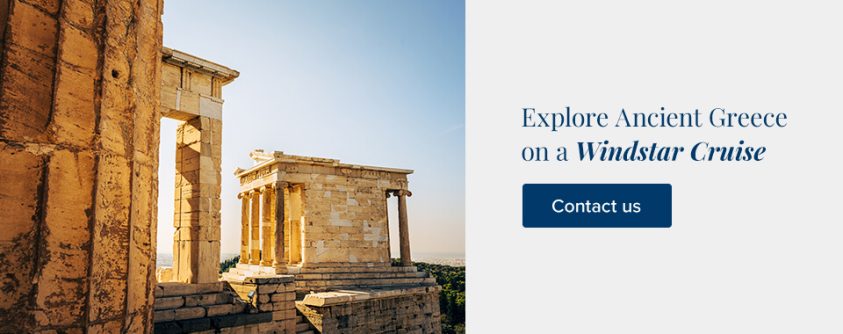
Are you ready to explore the remains of one of the world’s most influential civilizations? We can take you there.
Indulge in authentic Greek cuisine, visit ancient historical sites and experience the beauty of the Mediterranean coast with us. Our small ship size means you can enjoy all the excitement of a world cruise without the crowds. Enjoy an intimate, relaxing experience with fascinating on-shore excursions and personalized attention from our ever-attentive crew.
Give us a call to speak with one of our knowledgeable vacation planners about our Greek and Mediterranean cruise options.

